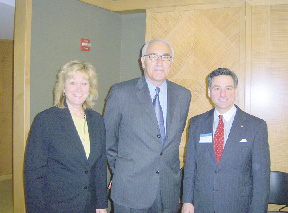The CRE New England/Upstate NY chapter held its second event for 2010 at Meredith&Grew in Boston. Ray Torto, CRE and global chief economist for CB Richard Ellis gave his 2010 Real Estate Market Outlook to a group of approximately 28 CREs and guests. Torto started the program with his conclusion that he is optimistic on the outlook of real estate. He then dove into the details. He felt that the economy is like a patient in a hospital. It was going through a trauma about 18 months ago with the Lehman event and the world coming to a complete stop. All economic events were postponed. Today, he feels that we have found the body and now are making decisions to move the economy forward and are also making real estate investments. Some real estate market prices are actually increasing in anticipation of a rebound. In 2010, good prices are being paid but he still considers the year a flat year.
Investors are focused on core properties only and are not expanding acquisitions to diversify. Torto is now looking at the market and is positive about its outlook. He is not looking at any specific property type outlook, just the general health. We went through this trauma and spent 6 months in the emergency ward. Now we are in the recovery room of the hospital and will be there for a long period of time, perhaps 2 years, but we are still in the hospital. We are moving forward but slowly.
Commercial debt is a problem but not the same tough problem that we experienced with residential debt. Commercial debt is a smaller debt total than residential debt. Torto does not see the same issues with commercial as with residential debt.
De-leveraging will be important to the health of the nation and it must begin. The 2Q of 2009 was the highest debt level since 1977 at $3.4 trillion. In 1999, the global debt was at $1.4 trillion. In 2010, there is $1.6 trillion in commercial banks and that is where the problem exists. 40% of origination was with CBMS financing but that means 60% was from other sources. The CMBS debt issue is not the lion's share of the problem. Much of the CBMS debt is not due to expire until 2017. The real problem is with commercial banks.
Case-Shiller Residential Index
Torto used the index to show that the serious decline was with residential, and not commercial, real estate. He compared the index from Dec. 2000 to Dec. 2009. The index at 100 was set at Dec. 2000. In Dec. 2009, the index hit 108. It peaked in Nov. 2007 at 192. Since Nov. 2007, the index has had a 30% decline with the Case-Shiller index and a 43% decline in the residential index. Torto then asked "why is commercial real estate being hit so hard?" Most of the commercial real estate debt is 60% LTV. Maybe there is an overreaction to the commercial real estate situation. He felt that there is ample global equity to make up any equity gap but there is not an adequate number of quality properties to purchase. The problem is the supply side of quality properties and not the demand side.
Part two will appear in the May 14th edition of the NEREJ.
Robert Nahigian FRICS, CRE, is the 2010 CRE chairman of CRE/NE and president of Auburndale Realty, Co., Newton, Mass.Rob Nahigian, CRE
Tags:









